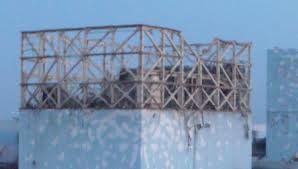
 The official death toll has risen to over 3,700 and is expected to end up over 10,000. Entire towns have been washed away in the tsunami and will take years to rebuild. Estimates put the total damages at over $100 billion. However, despite the tragedy felt throughout country by the magnitude of this natural catastrophe, it all seems overshadowed by the silent and invisible danger which is brewing at the Fukushima Daiicha Nuclear Power Plant.
The official death toll has risen to over 3,700 and is expected to end up over 10,000. Entire towns have been washed away in the tsunami and will take years to rebuild. Estimates put the total damages at over $100 billion. However, despite the tragedy felt throughout country by the magnitude of this natural catastrophe, it all seems overshadowed by the silent and invisible danger which is brewing at the Fukushima Daiicha Nuclear Power Plant.
Wednesday morning local time (over 12 hours ago), reactor #3 was emitting white smoke. Radiation levels at the plant surged and the remaining 50 workers were evacuated, but were allowed back an hour later. It was announced that the white fumes may constitute radioactive steam that has breached unit #3’s containment. This means that it is now suspected that both reactor #2 and reactor #3 have suffered ruptures in their containment vessels and are leaking radioactivity. On top of it, another fire broke out at reactor #4 and authorities are not sure why. While #4 is off-line and not functioning, the level of water in the reactor’s pool storing spent fuel rods may have dropped, exposing the rods. Even when nuclear fuel rods are not in use, they will remain very hot for weeks or months. Unless the rods are kept cool with a steady supply of water, their outer casings can melt away releasing radiation into the air.
ABC News quoted Yukio Edano, chief cabinet secretary and chief government spokesman, as saying, "There is no doubt that unlike in the past, the figures are the level at which human health can be affected." Radiation levels as high as 400 millisieverts an hour have been recorded at the Fukushima plant. What’s normal? The BBC lists the current limit (averaged) for nuclear industry employees as being 20 millisieverts per year. 100 mSv/yr is the lowest level at which any increase in cancer is clearly evident and 300 mSv/lifetime was the criterion for relocating people after Chernobyl accident.
Prime Minister Naoto Kan has warned the public of the risk of more radioactive leakage and urged people living within 30 kilometres of the plant to take safety precautions. "Depending on what happens at the power plant we would like to ask you to remain indoors at your home or in your offices. We would like to ask you to remain indoors and avoid going outside."
Recap
All reactors have a containment vessel which house the nuclear rods and are designed to hold in any radiation even in the event of a meltdown. However, officials say that the containment vessels of units 2 and 3 have breaches which are letting radiation to escape.
The outer buildings of units one through three have been destroyed by explosions caused when technicians vented steam from the containment vessels to ease pressure. Rods in units 1 and 2 are believed to be damaged or melted.
While rods at units 4, 5, and 6 were removed for maintenance before the quake, they were being kept in cooling ponds outside the containment chambers. They remain hot for weeks or months and must be constantly cooled otherwise there is the risk the outer casings melt away releasing radiation.
British Columbia snaps up potassium iodine
B.C. residents have been going nuts scooping up potassium iodine (Vancouver Sun). Why? It has been prescribed as a means of protecting the thyroid gland from cancer due to radiation exposure (Wikipedia) however the possibility of radiation coming from Japan is currently nonexistent. Provincial health authorities are recommending against self-medication as potassium iodine – available without a prescription – can cause health problems, such as heart palpitations, gastrointestinal aggravations and rashes.
Euronews – Mar 16/2011
Radiation hike forces temporary evacuation of Fukushima…
A radiation surge at Japan’s stricken Fukushima nuclear plant temporarily forced the remaining workers there to pull out. White smoke could be seen billowing from the complex -it is thought a fuel pool at the No.3 reactor may have heated and produced what could be steam. Fifty employees were eventually allowed to return after radiation levels fell again. However the government may now seek direct US military help to end the crisis.
The Washington Post
Map of Japan showing the state of Japan’s power grid
The Washington Post
Map of japan showing the quake’s epicentre and where tsunamis hit
The Washington Post
Japan’s nuclear emergency: 9 diagrams of what’s happening at Fukushima
Japan: Dramatic Footage – Tsunami – 7min Video March 14
http://www.youtube.com/watch?v=lfHrpC-ArHc
New Dramatic Video: Tsunami Wave Smashes Away Homes in Japan
http://www.youtube.com/watch?v=VCMdPzwdRbc
New!! Dramatic Video Footage of Japan Earthquake Tsunami!!
http://www.youtube.com/watch?v=SPTRQXz6f9c
Oil tanker swept away by tsunami in Japan
http://www.youtube.com/watch?v=Q4lZq4zXwWU
Japanese Tsunami Footage – Up Close and Personal
[This video shows how quickly the water came into cities and its power to sweep away just about anything in its path. Just imagine watching this outside you window. It must have been terrifying.]
http://www.youtube.com/watch?v=jGMRaOKdR2w
Click HERE to read more from William Belle
Article viewed at: Oye! Times at www.oyetimes.com

[b]Horrible[/b] :(((( !
God bless Japan! 😥